Risks and risk mitigation: A business guide for IT projects
This article explains how to build appropriate cooperation and communication between project stakeholders to mitigate risk and achieve the expected project outcomes.
The dynamic growth of the IT sector has led to significant interest in improving the effectiveness of software development projects. Most successful IT products are a combination of ideas and experience from a customer and a software developer. In order for both sides of the project to focus on co-creation and technology, it is important to correctly define the cooperation model to be used. Such a model establishes the organizational and financial conditions for the project, its duration, the possibility of making changes and the distribution of responsibilities and risks. Below, the main cooperation models and their characteristics will be analysed, as well as criteria and an algorithm for choosing the most appropriate model to correspond to a specific software development project.
Cooperation models differ in their distribution of responsibilities, risks, opportunities, and advantages associated with the project between the customer and the contractor. Since the focus is on project activities, it is advisable to consider the classification of cooperation models in terms of project management.
Depending on the type of development contracts, three cooperation models can be distinguished:
The use of a Fixed Price model means that the scope and budget of the project are precisely determined in advance.
In the T&M cooperation model, the customer accepts and pays for all working hours and material costs, regardless of the time it takes to complete the project.
Under the terms of a Cost reimbursable contract, the contractor is entitled to compensation for all reasonable costs associated with the development of a product, as well as a certain fee as profit for their work.
Each of the main types of cooperation model can be divided into several more categories that are often encountered in practice. Optional and derivative forms of interaction arise when parties attempt to anticipate the specifics of the work plan or establish additional incentives for the project team. This can be seen in the example of Cost reimbursable forms of collaboration:
As mentioned above, the classification of cooperation models in project management is based on different types of contracts. However, cooperation includes many components aside from legalities. Organisational, informational, technological and human factors are also important, as well as the specifics of software development.
Depending on project duration and the level of client involvement in the development process, it seems reasonable to divide the cooperation models into:
Let us consider each of these three cooperation models one by one.
This cooperation model assumes a predetermined scope of the project, a set deadline, and an agreed-upon price. Its advantages include fixed budget and duration, no idle time and high project manageability.
Theoretically, the following varieties of this model can be distinguished:
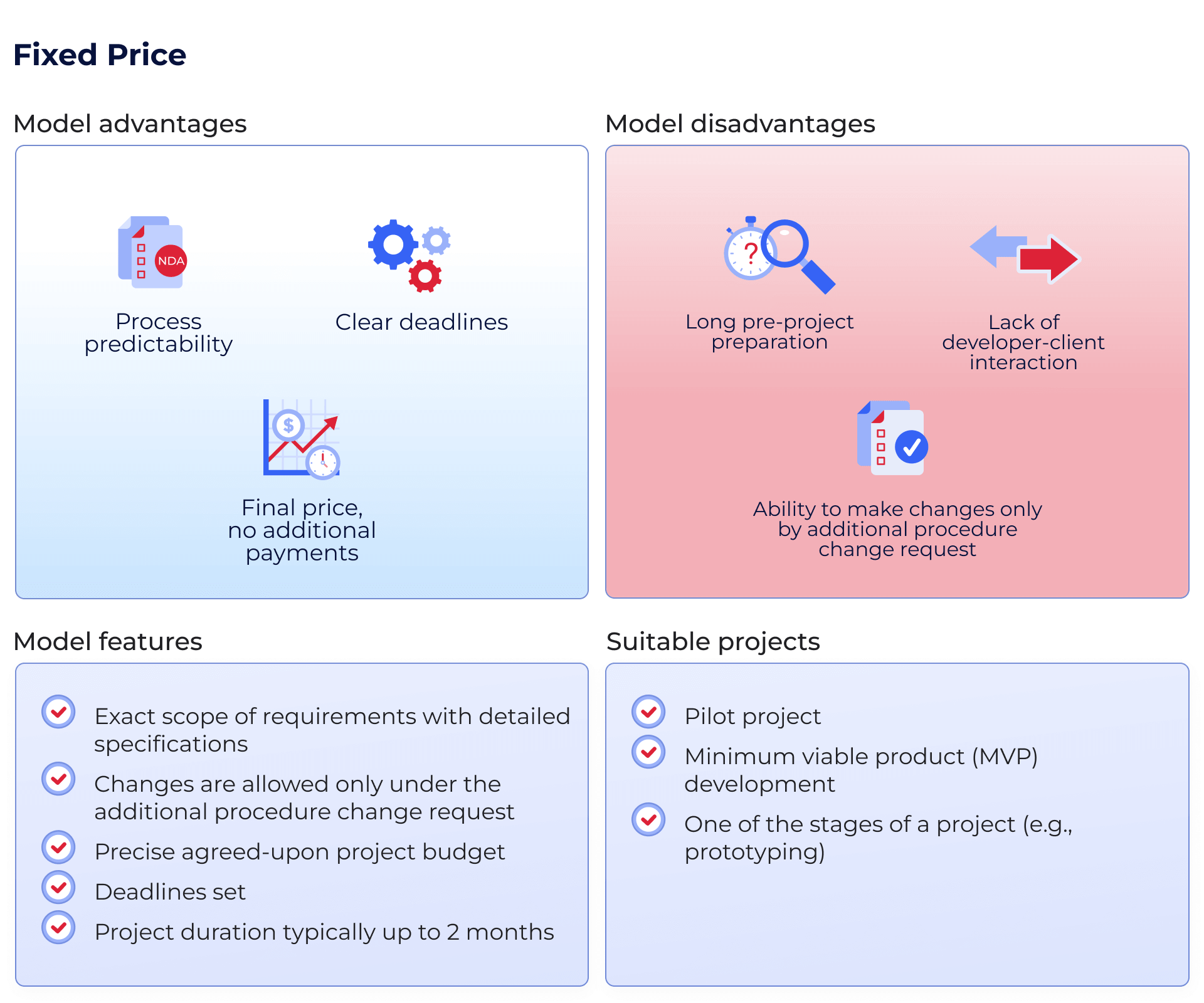
Working with this model seems straightforward, but it requires a certain amount of experience and careful preparation. The start of work using this model is relatively quick. However, pre-project preparation can be lengthy, requiring drawing up a detailed contract with job specifications. Responsibility for the risks of imperfections or poor quality of specification rests entirely on the client.
In a short-term project, the customer is sufficiently distanced from the process. If something goes wrong in development, the client may not have time to react to unforeseen failures and must assess them after the completion of the project.
This model also does not provide the ability to quickly restart development. The client must again go through the stages of business analysis, specification, negotiating and signing a new contract.
Other cooperation models could be more suitable, making it possible to quickly make changes and fix bugs during the project.
When working within this model, the development cost is determined based on the hours worked by the project team and other costs associated with the project. At the beginning of cooperation, the project parties agree on an hourly rate and set goals. Payments are typically made monthly, calculated based on the agreed-upon hourly rate and the actual number of hours worked per month. The T&M model assumes a high level of client involvement in the project and the absence of detailed specifications.
The strengths of this form of cooperation include a quick start of 2-4 weeks, a flexible plan and work schedule, and the possibility of changes. At the same time, the customer who ordered development according to the T&M model should be prepared for the fact that the cost and timing of work cannot be exactly known in advance but can only be approximately estimated. Additionally, there may be staff turnover among developers, and the level of knowledge retention in the project may be low. However, with this method of organizing contractual relations, the client can turn to a trusted IT solution provider with a newly emerged idea and immediately start joint work.
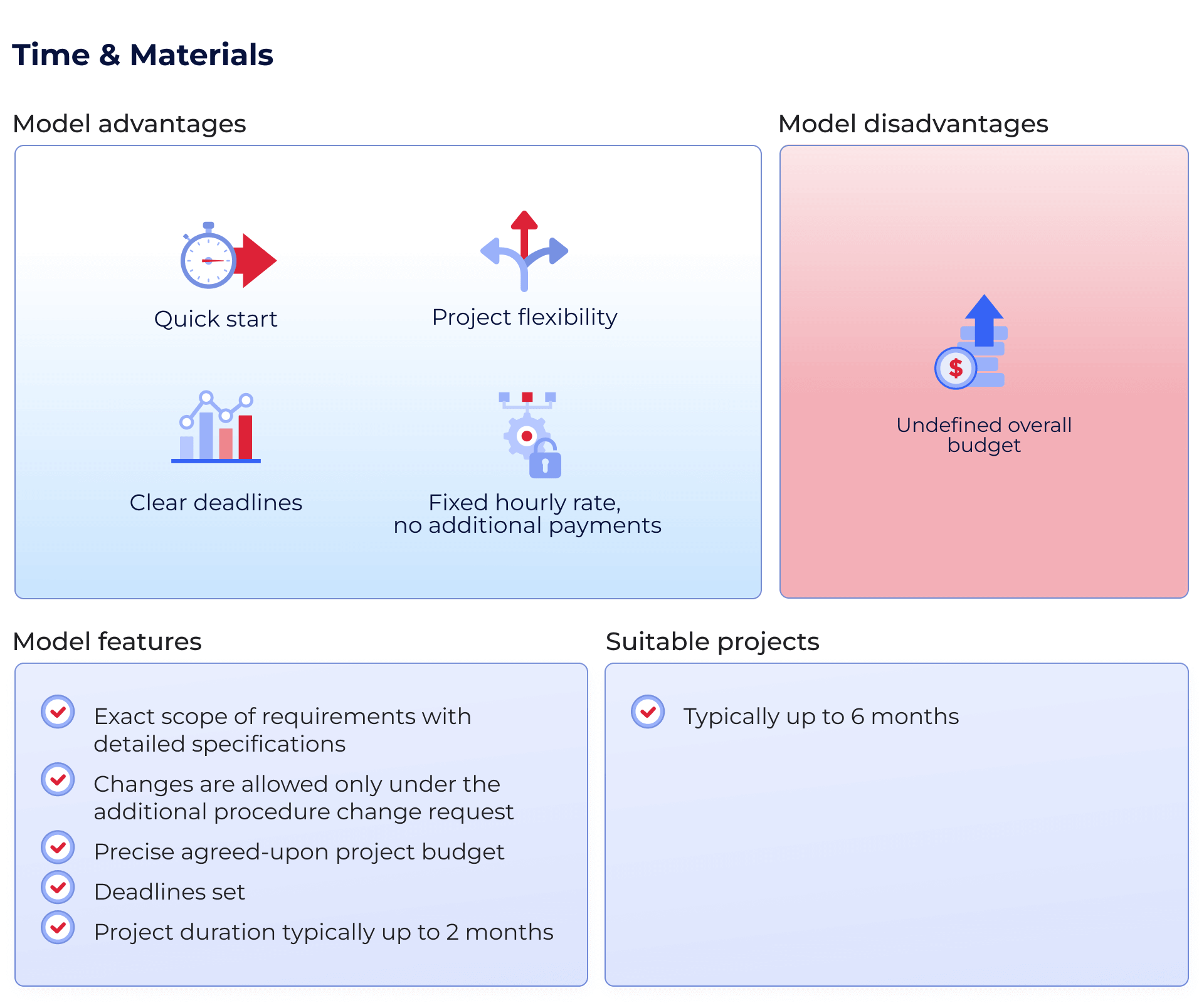
T&M model in practice can be clearly visible in the working process of improvement of the property management system (PMS) Visbook for HoReCa businesses.
The team continues to constantly improve and upgrade the system to keep it up to date. In this project, it was possible to use the strengths of the T&M model, including changes in the scope of the project, flexible planning and scheduling, and the ability to involve an additional number of specialists without lengthy preliminary negotiations or signing additional contracts.
Using a Dedicated Team model, a team of experts is created to focus exclusively on the development of one software project. SSA Group offers completely transparent Dedicated team pricing. The monthly payment per consultant consists of the consultant’s salary plus the administrative fee. With a properly structured process of building a dedicated team, the client and the IT service provider jointly select specialists.
The client has full control over the team’s working time but can also regulate their involvement in the process. The monthly payment is predictable, however, the client can adjust the intensity of work in the project. For example, if some result needs to be achieved as soon as possible, an agreement can be reached on paid overtime for the project team.
The Dedicated Team model allows developers to start with incompletely defined requirements. The project scope is determined throughout the progress by the joint efforts of the customer and the IT service provider. Given the long-term nature of projects that last over 6 months, the members of the dedicated team are able to achieve domain expertise and the necessary niche specialization. This model ensures the accumulation and retention of knowledge, and a high level of scalability and reliability.
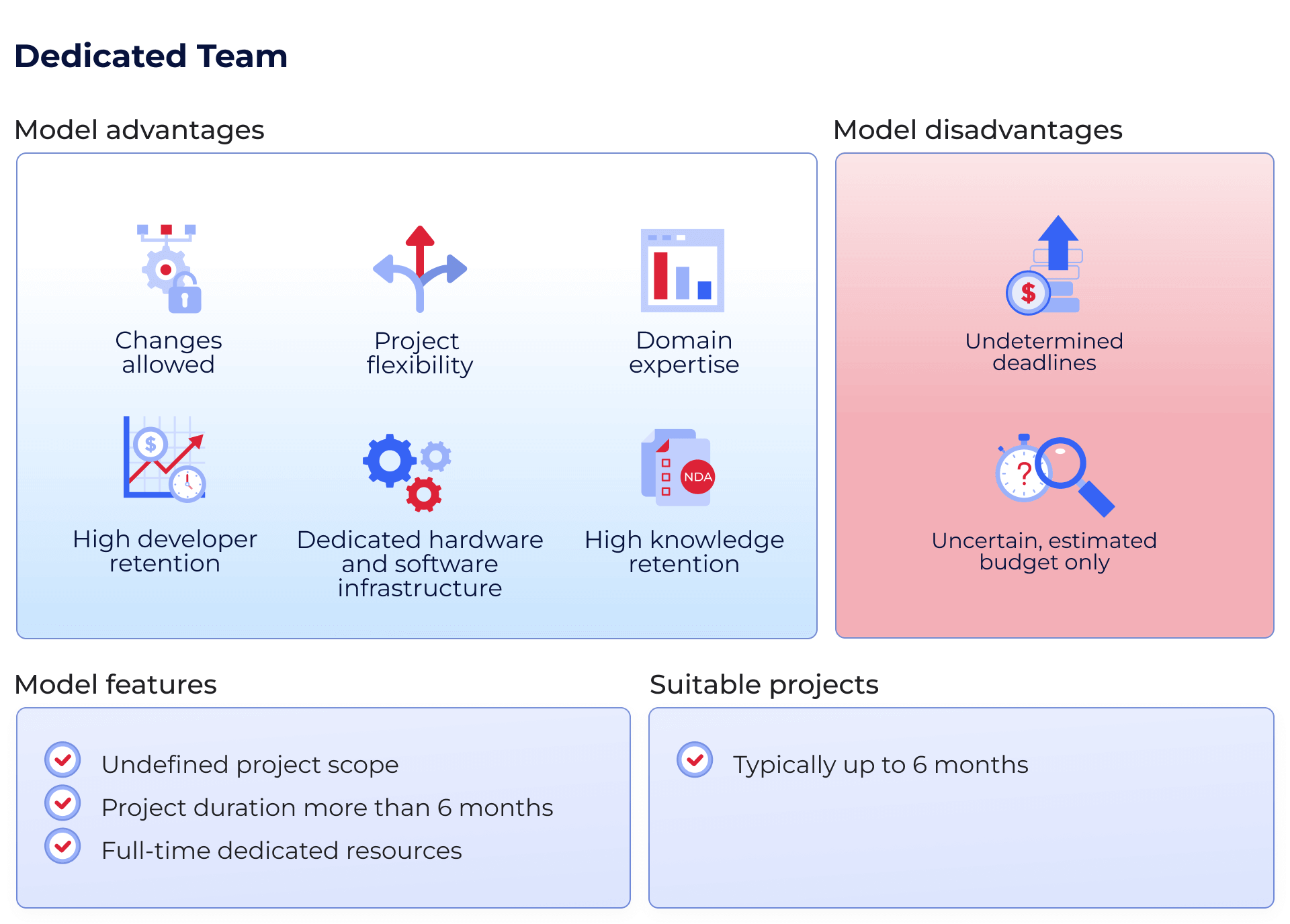
The Dedicated Team model is the most flexible model which allows clients to achieve business goals by combining the efforts of the in-house team and a dedicated team of the IT service provider.
An example of this model used in a project is an AI-driven leadership tool for automating corporate productivity. Consistency of the team composition and close communication of all participants ensured the coherence of work, retention of acquired knowledge and experience and sustainable development of the project.
When talking about cooperation in the IT industry, one cannot ignore post-project maintenance. All major players in the software market strive to constantly improve and keep their products up-to-date.
In terms of technical support, there is no such variety of models as in development. As a rule, everything is determined by the amount and cost of the working time allocated by the client. Additionally, the intensity of information exchange and the speed of response to client requests are very important for successful service. These issues are regulated within the framework of the cooperation model.
Choosing a cooperation model will depend on the type, duration and specifics of the project. A comparison of the primary cooperation models can elucidate several patterns.
The resource-based model ensures effective long-term partnerships, while the project-based cooperation models are better suited for short-term or pilot projects.
The Fixed Price model is suitable for small or pilot projects but does not provide the necessary flexibility and willingness to allow changes. After evaluating the results of a pilot stage, clients can decide on the feasibility of continuing the project and defining a different cooperation model to complete it.
The T&M model performs well in conditions of uncertainty, such as if the features of the product are not fully thought out. In this form of work organization, development progress can be achieved, but it is difficult to control the development time frame. The risks of loss of knowledge and know-how gained during the implementation of the project are also high. T&M works well with the tasks of medium and long-term projects, especially considering the variable workload and the amount of working time. The detailed comparison of models is presented in a table.
The Cooperation Model Selection process can be schematically shown as follows.
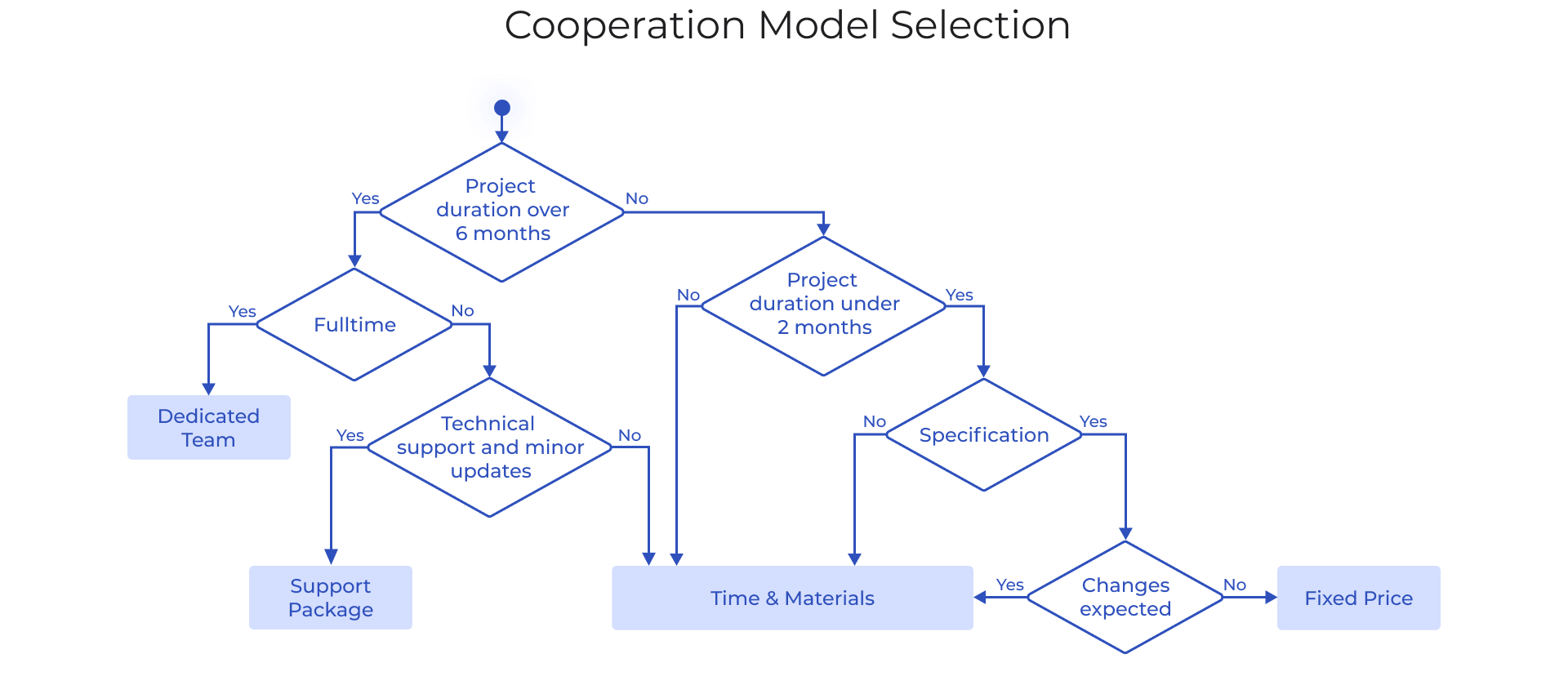
When initiating a project, one should also consider the cost/retention ratio, which is visually shown below.
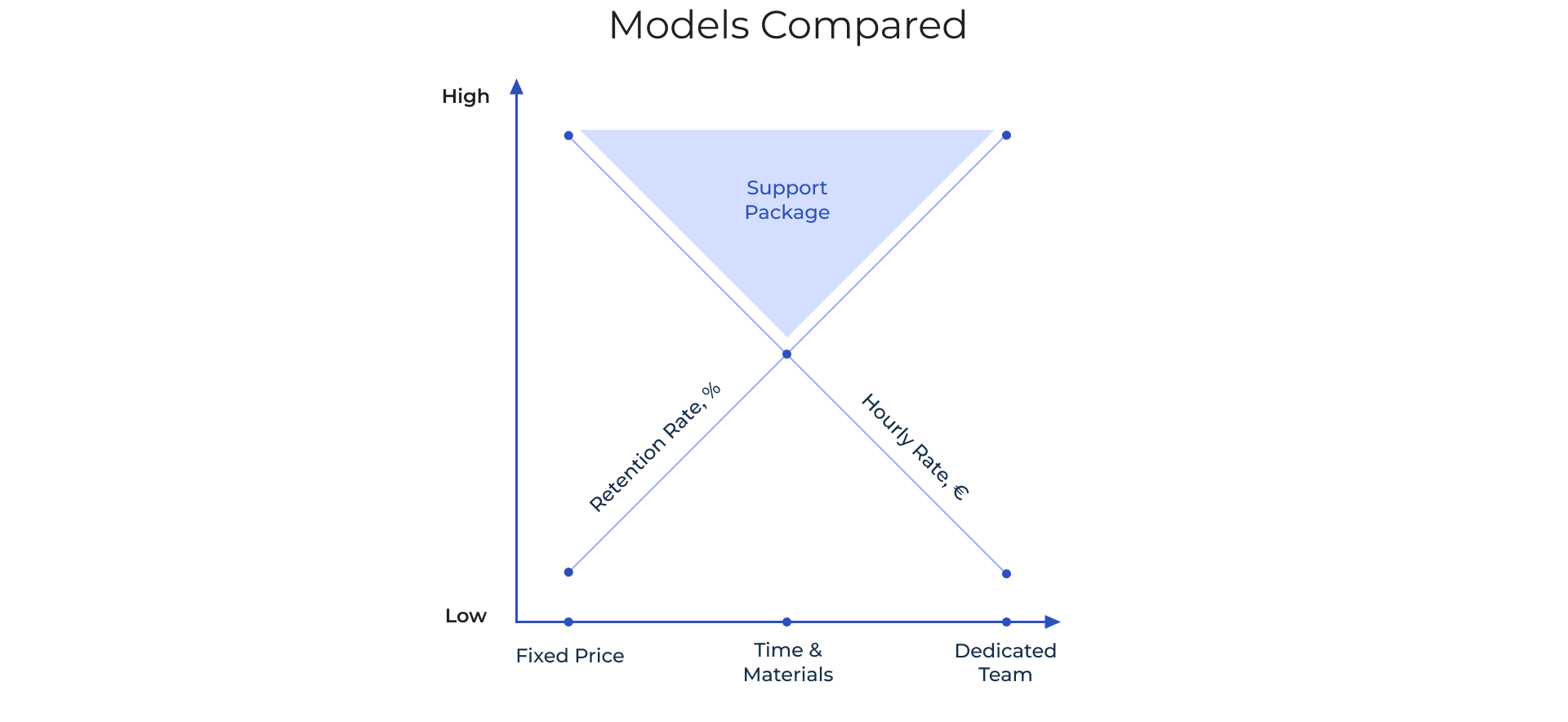
It should not be forgotten that the relationship between the client and the developer can change, consistently passing through different forms of cooperation. A short-term contract corresponds to the initial stage of cooperation, the T&M model ensures flexibility and increased interaction, and the Dedicated Team model indicates the strengthening of mutual trust and long-term joint plans.
Similarly, different forms of cooperation can be applied at different stages of the development of one software product. In this case, for example, the minimum viable product (MVP) could be developed using the Fixed Price model, the further functional improvement could be carried out on the Time&Materials model, and the launch of a Dedicated Team can be applied to the development of a full-scale product.
A comparison of different collaboration options shows that the Dedicated Team model is best suited for a long-term, value-adding project. Indeed, in this case, due to the combination of creativity and expertise of the customer and developers, a synergy effect arises. Some projects can only be performed by dedicated teams.
We considered the details of the primary types and varieties of IT cooperation models that can be used in various types of software development projects. Practice shows the importance of matching the type of model used with the specific needs of the project.
When starting a project, discuss your partnership model with the SSA Group team. We offer flexible solutions, making the cooperation mutually beneficial, no matter what type of project you plan to develop.

This article explains how to build appropriate cooperation and communication between project stakeholders to mitigate risk and achieve the expected project outcomes.
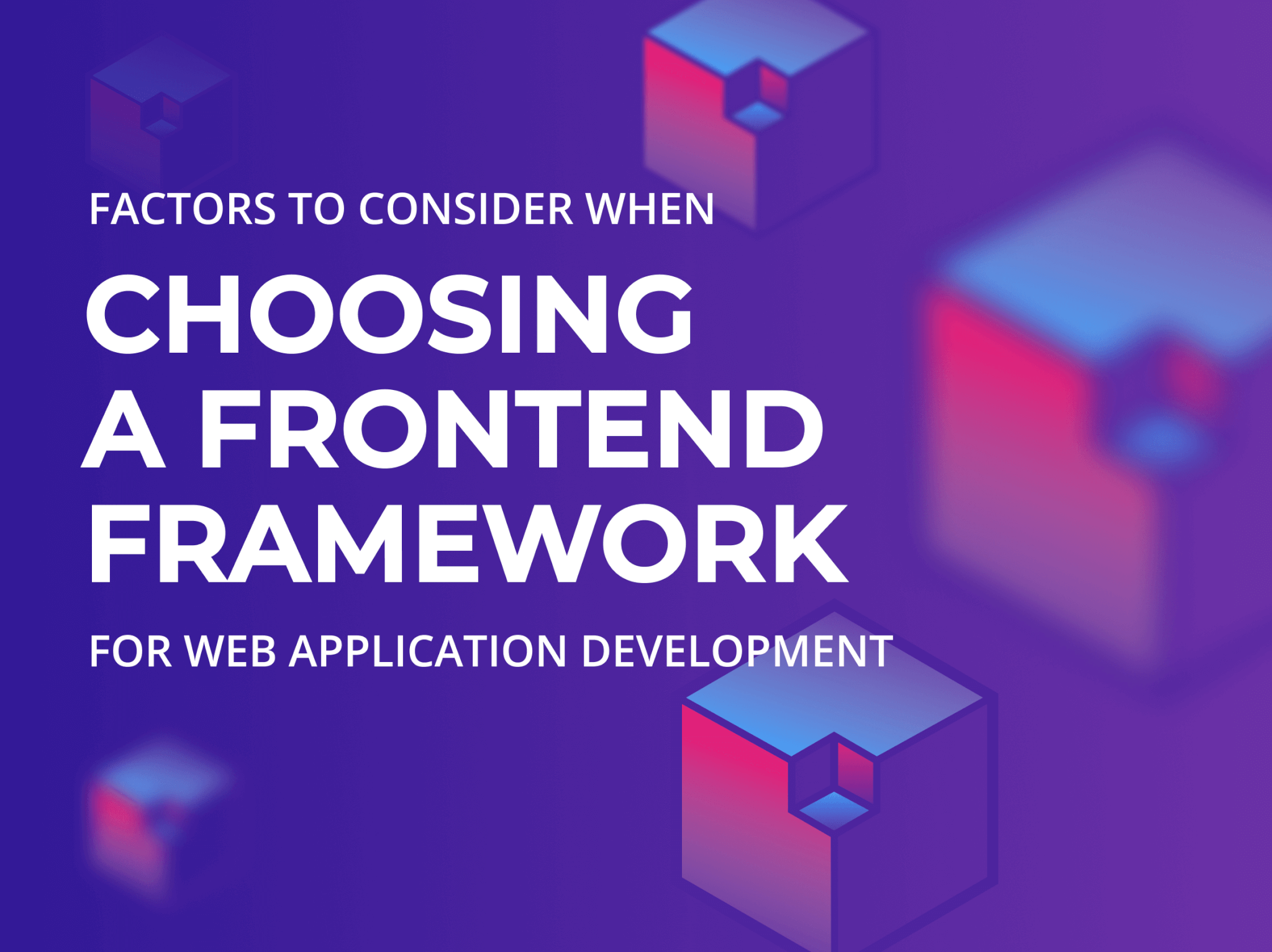
Choosing a frontend framework for app development is a crucial element of product success. That’s why we examined popular and emerging frontend technologies.
you're currently offline